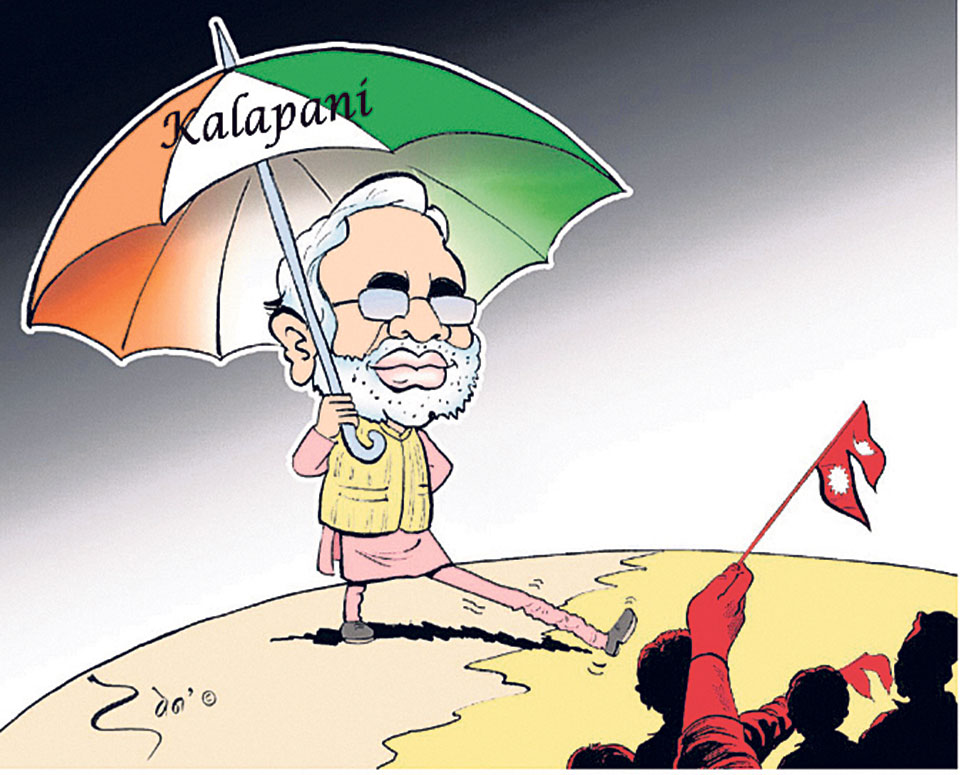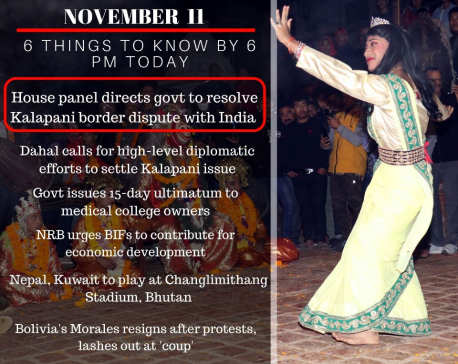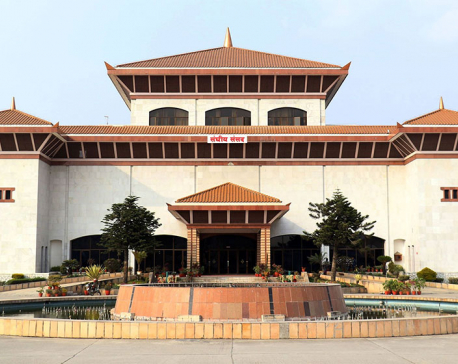
OR
The battle for Kalapani
Published On: November 25, 2019 08:33 AM NPT By: Mahabir Paudyal | @mahabirpaudyal


Mahabir Paudyal
Mahabir Paudyal is an opinion writer at Republica with interest on history, domestic politics and international relations.mahabirpaudyal@gmail.com
More from Author
- Nepal is falling into a trap of India, China and the US
- Prime Minister Oli is pushing the country to precipice. Is there a way to stop him?
- How can you be so irresponsible about education?
- What is Nepali Congress thinking about China?
- Fellow Nepalis, fear the government, fear as much for the country
India may keep ignoring Nepal’s legitimate claim on Kalapani but it will leave Nepal with the reason to feel hurt, betrayed, angry and aggrieved. It will breed resentment all around
Kathmandu is fighting a battle with facts and evidence for Kalapani, the land area that actually belongs to Nepal but which India has been claiming, occupying and using as its own for many decades. Without some kind of assurance from New Delhi that what is Nepal’s shall remain Nepal’s, or without some conciliatory approach, Kathmandu and New Delhi look headed toward sour, even fractured, ties, we don’t know for how long.
These were the good times in Nepal-India relations. Kathmandu and New Delhi were burying hatchets. In Kathmandu, Ambassador Manjeev Singh Puri had avoided actions that could potentially damage the friendly relation. His approach to Nepal was markedly different from his immediate predecessor’s.
Completion of Motihari-Amlekhganj petroleum pipeline—the first-ever cross-border petroleum pipeline in South Asia—in September this year was an inspiring event in Nepal-India development cooperation. When Nepali Prime Minister and his Indian counterpart jointly inaugurated the project, it sent the impactful message to Nepal. Nepal and India were emerging from the dark shadows of the blockade, it seemed.
Then came up Kalapani (I use Kalapani as a metaphor here to include all encroachment issues including Susta, Lipulekh, Limpiyadhura and others).
That India is occupying Kalapani area is not an old story in Nepal but when, on November 2, the new map released by government of India to show union territories of Jammu and Kashmir and Ladakh also included Kalapani area, Kathmandu reacted: India, are you kidding? Protests erupted across the country. The government had to do something.
Foreign ministry issued a statement objecting to India’s map. India responded by saying Nepal’s claim is invalid.
Stories of loss
Since November 2, Kalapani is the most discussed issue in Nepal’s social media, news media and public spheres. People are trying to figure out how Kalapani went under Indian occupation.
Though its history goes 200 years back, larger Nepali community came to know about Kalapani in the 1990s after the end of Panchayat system. The situation of the country at the time was such that not only Kalapani, most of Far-west was isolated from Kathmandu. To reach Mahendranagar or Dhangadhi from Kathmandu, you would have to go through India. Only after completion of Mahendra Highway in 2000, the Far-west and Kathmandu interfaced. It was no wonder, therefore, that very few knew about Kalapani until the 1990s.
We do not actually know when exactly Indian forces entered and set up the camps in Kalapani. There are only some bit of speculations, oral accounts and inadequate researches.
One such source has been Buddhi Narayan Shrestha whose Border Management of Nepal is among the most cited book. Shrestha, however, has not provided definite answer, other than speculation, regarding how Kalapani went under Indian control. One standard speculation goes like this: During the 1962 war with China, Indian troops were being pushed downward by Chinese troops. The Indian forces retreated and finally arrived at Kalapani. They saw that it was a strategic location and set up military base just in case the Chinese resumed fight.
Could this be true? Could India at the time have thought the land belonged to India? We don’t know. Could India have communicated about this to King Mahendra? Could King Mahendra have conceded that piece of land to India? We don’t know for sure.
Nepal-India ties were souring before India-China war. Jawaharlal Nehru was sore with Mahendra for signing the agreement with China to build the Araniko Highway. Following this, India had briefly imposed sanctions on Nepal too. Mahendra had been trying to calm down the Indians by saying communism does not come by taxi. Geopolitically, the late 50s and the early 60s were very unsettling times for Nepal. Could Mahendra have allowed India to use Nepali land for the purpose of using it against China? We don’t know that either.
Another story has it that King Mahendra also did not know about Indian occupation of Kalapani for long. He came to know about it in the late 1960s, when he had taken a bold move of removing Indian military mission from Kathmandu and sending back the Indian troops stationed in various border points in the north. Shrestha has recorded some controversial statements attributed to people who knew and worked with King Mahendra. Rishikesh Shah is mentioned as saying “I was the minister when the (Indian) military was deployed at Kalapani. King Mahendra unwillingly overlooked the issue then.” Shah mentions King Mahendra as saying “I have already angered India too much, India has become like a raging fire—now let it take the seat in Kalapani.”
There is a sharp rebuttal to this claim as “nonsense” by Shailendra Kumar Upadhyay who argues that “nationalist like King Mahendra, who had made the courageous decision to drive away Indian check posts” could never have given consent to India “to deploy its troops at Kalapani.”
Mahendra haters in Nepal, as is their wont, have always demonized him and portrayed him as the cause of every single problem facing the country today. Kalapani debate has provided them an excuse to demonize him further and ridicule the nationalists yet again. This deceitful distraction, however, is not something we need to worry about much.
What we need to worry about is we do not have adequate literature on Kalapani, and we are losing all those who knew Kalapani issue better and who worked with King Mahendra: Kirti Nidhi Bista, Surya Bahadur Thapa, Rishi Kesh Shah, Shailendra Kumar Upadhyay to name a few.
In India too we had leaders who indirectly admitted to Kalapani belonging to Nepal. Buddhi Narayan Shrestha has documented this story too. Indian Prime Minister I K Gujaral is mentioned as saying in 1997 that “technicians from both sides are engaged in the demarcation of border” and that “if their reports conclude that the [Kalapani] area belongs to Nepal, we will immediately withdraw from there.” Likewise, Jaswant Singh, who was India’s Foreign Minister, is attributed as saying in 1999: “Nepal-India joint technical level boundary committee has been properly instructed to expedite the work of demarcation by investigating into the facts about all the territory in the western sector including Kalapani region.” There were lawmakers like Anand Pathak who said: “Indian troops should be withdrawn from Kalapani. If Nepal has been subjected to injustice in Kalapani, then India must immediately withdraw.”
None of these three men are with us today.
We are soon going to reach a point when we will have nobody to ask about Kalapani. This is why it is critical to record, document and archive the experiences and accounts of people like Buddhi Narayan Shrestha, Bhairab Risal, Ratan Bhandari and Dwarika Nath Dhungel, who have been to the field, studied historical documents and done researches on Nepal’s borders.
But take a pause here. We have one more person who can tell us the truth about this: Gyanendra Shah, the former king. When Indo-China war broke out he was 15. Thus he may have had some memories. When Indian troops were removed from northern border points in 1969, he was 22, and when his father passed away he was 25. Early twenties is the age when one develops awareness about history and politics. Former king must know something about it.
Nepal unites
It is uncommon in Nepal for all parties to come together for a national cause. But this time around, every single party has the same voice about Kalapani. Even Madhesi parties, which have traditionally maintained silence on India’s highhandedness, attended the all-party meeting called by the prime minister on November 9 and came out with one voice: Kalapani, Lipulekh and Limpiyadhura are Nepali territories and Nepal should convince India to forgo its claims on them through diplomatic and political channels.
Political parties seem to be competing to prove themselves more concerned about Kalapani than others. They are questioning the ‘nationalist credentials’ of ruling Nepal Communist Party and its prime minister K P Sharma. Perhaps to address them too, the government, on November 22, sent formal diplomatic note to India over Kalapani issue.
Nepali political parties have united for Kalapani for two main reasons. One, they have realized now that when they fail to unite even during the worst times, they can be completely rejected by the people. Besides, its by-election times in Nepal. Pledge of loyalty to the nation helps win people’s hearts, if not anything. Leaders tend to project others as less nationalist. Nepali Congress president Sher Bahadur Deuba has alleged that PM Oli gave consent to India to include Kalapani in its map. He may have thought saying so would help win some votes. But it has backfired—he has been heavily criticized for making such unsubstantiated and irresponsible remark.
In India, however, different narrative seems to be emerging. India, apparently, thinks protests in Nepal are provoked by anti-India elements. Indian media is giving off the tone of shock and bewilderment. “How come Nepal, India’s friend, become naraaj with India all of a sudden?” They point to Pakistan and China. One story recently published in The Hindustan Times writes about Chinese encroachment of Nepali territory and people protesting in Tarai plains, even burning the effigies of President Xi Jinping. Given that this particular newspaper had presented false stories of Nepal during the blockade too, I was not surprised. But diversion does not help solve the issue.
Yes, there are reports of encroachment from the Chinese side. Nepal should talk to China, hopefully it will. But encroachment from the north and Kalapani are apples and oranges.
Meanwhile, in Nepal, the game of lambasting nationalism and nationalists is going on. They have built the narrative that Kalapani is the test of K P Oli’s nationalism, that he is going to fail this test and that his nationalist credentials are going to be exposed. Strangely, they are among those who justified the blockade in 2015.
Whenever Nepal-India relations reach a souring point, mainly two kinds of narratives are created in Nepal. Extremists say retaliate, even go to the war. Others have always stressed on diplomacy, political conversation at the highest level and trust building.
At the third front, you have those who scorn nationalism and nationalists but at the same time also chide leaders for not being nationalist enough. These Janus-faced people need to be read with extreme skepticism.
Message to India
Call it a small country syndrome or a sense of insecurity, but Nepal has always wanted every issue with India to be sorted out amicably, through dialogue and diplomacy. Provocateurs have always defined Nepali nationalism as anti-Indianism and Nepali sentiment as anti-India sentiment. But this does not characterize Nepal-India relation. History and geography have yoked us together in such way that we cannot afford hostility.
Nepal and India, in principle, have already agreed to resolve border related issues. The Eminent Persons Group (EPG) was formed for the same purpose and it has finalized its report, possibly with all the evidence and facts. This is the instrument Nepal and India should use to resolve the pending issues.
If Kalapani is a strategic location for India, it is so for Nepal too. Geopolitics is an unpredictable game. Besides, for a large nation like India—22nd times larger than Nepal—a small strip here and there, some square meters and kilometers here and there might not matter much. For Nepal, every inch of land is priceless.
India has easy choices. Listen to Nepal. Come up with your evidence and ask Nepal for Nepal’s. If King Mahendra had conceded that territory to India, India must have some evidence to that effect too. India cannot be a country without institutional memory. So come with your evidence, sit and talk, compare and assess each other’s claims and counterclaims and evidence and counter-evidence. This is the path of resolution. Second choice is also easy: Keep ignoring Nepal’s legitimate claim on Kalapani. This will leave Nepal with the reason to feel hurt, betrayed, angry and aggrieved. This will breed resentment all around.
India demonstrated a great diplomatic finesse when it resolved all border-related disputes with Bangladesh in 2016. With Nepal, it must be even easier because we are not in border dispute with India in a true sense. Some of our lands have been encroached upon and occupied by India and Nepal wants that India stop doing so, in a truly neighborly manner.
But for this both India and Nepal should agree to this principle: I do not take an inch of your land, I don’t leave an inch of mine either. I respect your territorial integrity. You respect mine too.
Perhaps, American bard Robert Frost was sending a profound message to the nation-states when in 1914 he declared: “Good fences make good neighbors.”
mahabirpaudyal@gmail.com
You May Like This

UK-based group says new Indian map illegal
KATHMANDU, Dec 7: The Global Policy Forum for Nepal (GPFN) has said that India's unilateral act to publicize its political... Read More...

Nov 11: 6 things to know by 6 PM today
Your daily dose of missed important news of the day. ... Read More...

House panel directs govt to resolve Kalapani border dispute with India through diplomatic channels
KATHMANDU, Nov 11: The State Affairs Committee of the Federal Parliament has directed the government to resolve the border issue... Read More...







Just In
- NRB to provide collateral-free loans to foreign employment seekers
- NEB to publish Grade 12 results next week
- Body handover begins; Relatives remain dissatisfied with insurance, compensation amount
- NC defers its plan to join Koshi govt
- NRB to review microfinance loan interest rate
- 134 dead in floods and landslides since onset of monsoon this year
- Mahakali Irrigation Project sees only 22 percent physical progress in 18 years
- Singapore now holds world's most powerful passport; Nepal stays at 98th











Leave A Comment